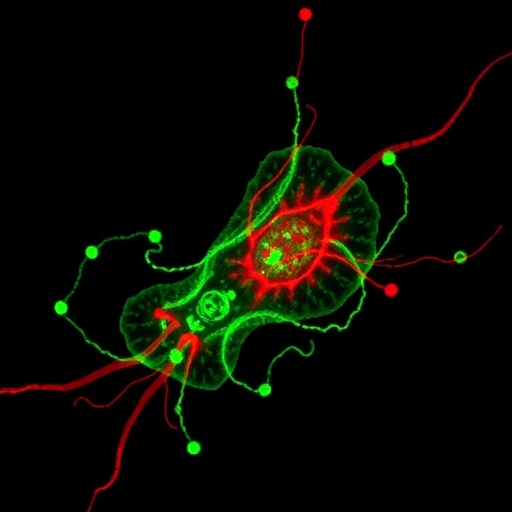In a groundbreaking study poised to reshape our understanding of programmed cell death, researchers have unveiled a novel mechanism by which a specific mutation in the protein RIPK1 modulates cell fate decisions critical to human health. The research, published in Cell Death Discovery, reveals that the RIPK1 S213E mutant acts as a potent suppressor of RIPK1-dependent cell death pathways by disrupting its interactions with pivotal downstream effector proteins, RIPK3 and CASP8. This discovery opens promising avenues for therapeutic interventions targeting inflammatory diseases, neurodegeneration, and cancer.
RIPK1 (receptor-interacting serine/threonine-protein kinase 1) is a crucial molecular switch that governs various forms of cell death, including apoptosis and necroptosis, both fundamental to tissue homeostasis, immune responses, and disease pathology. Precise regulation of RIPK1 activity is essential; its dysregulation can trigger excessive cell loss or persistent inflammation, underlying numerous chronic conditions. The new findings shed light on how site-specific modifications within RIPK1 can reprogram its activity and interactions, thereby fine-tuning cellular outcomes.
The study focuses on the mutation of the serine residue at position 213 to glutamic acid (S213E) within RIPK1. This site-specific mutation mimics phosphorylation, a common post-translational modification known to modulate protein function. Through a combination of structural analyses, biochemical assays, and cellular studies, the authors demonstrate that the S213E substitution significantly impairs RIPK1’s ability to bind two key molecules: RIPK3, a kinase integral to necroptosis, and caspase-8 (CASP8), a protease central to apoptosis induction.
.adsslot_mj56BniPWE{ width:728px !important; height:90px !important; }
@media (max-width:1199px) { .adsslot_mj56BniPWE{ width:468px !important; height:60px !important; } }
@media (max-width:767px) { .adsslot_mj56BniPWE{ width:320px !important; height:50px !important; } }
ADVERTISEMENT
Intriguingly, the inhibition of RIPK1’s interaction with RIPK3 and CASP8 by the S213E mutation effectively suppresses the execution of both apoptosis and necroptosis, two divergent yet interconnected cell death pathways. This dual repression underscores the regulatory power of single-site modifications within signaling cascades governing cellular demise. The suppression of these pathways suggests that S213E acts as a molecular ‘brake,’ preventing the runaway activation of cell death under conditions that would otherwise provoke tissue damage.
Mechanistically, the authors reveal that the S213E mutation induces conformational changes within the RIPK1 protein that obstruct the formation of the necrosome complex — a multiprotein signaling platform comprising RIPK1, RIPK3, and MLKL, which propagates necroptotic signaling. Additionally, this mutation diminishes recruitment of CASP8 to RIPK1, thereby inhibiting the initiation of caspase-dependent apoptosis. These insights highlight a fine balance between structural dynamics and functional consequences in death-inducing signaling complexes.
The experimental approach involved mutagenesis to generate the S213E variant and comparative analyses against wild-type RIPK1 in various cell models. Using co-immunoprecipitation and proximity ligation assays, the research team quantitatively monitored the protein-protein interactions that define cell death activation. Their data convincingly indicate a reduction in RIPK1-RIPK3 and RIPK1-CASP8 complex formation in the presence of S213E mutant proteins, correlating with decreased markers of programmed cell death.
Beyond molecular binding studies, the consequences of the S213E mutation were explored in cellular contexts exposed to death stimuli such as tumor necrosis factor-alpha (TNF-α) and zVAD-fmk, which normally elicit robust RIPK1-dependent apoptosis or necroptosis. Cells harboring the S213E mutation displayed pronounced resistance to these triggers, suggesting significant protective effects against pathological cell death. This phenomenon holds translational potential for diseases characterized by deregulated cell death and inflammation.
The importance of these findings extends to the realm of therapeutic design. Current pharmacological inhibitors of RIPK1 aim to modulate its kinase activity but can be limited by off-target effects or incomplete blockade of cell death pathways. Targeting specific protein-protein interaction interfaces, as exemplified by the S213E mutation’s mode of action, offers a refined strategy to selectively suppress detrimental pathways while preserving physiological functions that rely on RIPK1.
These insights are particularly relevant in contexts like neurodegeneration, ischemia-reperfusion injuries, and autoimmune disorders, where excessive or inappropriate cell death exacerbates tissue damage and disease progression. By fine-tuning the activity of RIPK1 through mutations or molecular mimetics, it may become possible to attenuate pathological cell loss and improve patient outcomes. Moreover, the research underscores the therapeutic promise of intervening at the level of protein complex assembly rather than solely focusing on enzymatic inhibition.
This study also raises fascinating questions about the physiological role of the S213 site in endogenous RIPK1 function. Whether dynamic phosphorylation at this residue naturally serves as a molecular switch controlling death pathway activation remains to be explored. Elucidating the upstream kinases responsible for modification at S213 and the cellular contexts in which such modifications occur could further illuminate the regulatory networks governing cell survival and death.
Another remarkable aspect of the findings is how a single point mutation can exert disproportionate influence over multiple cell death pathways, emphasizing the interconnectedness of apoptosis and necroptosis machinery. Understanding this crosstalk is vital for developing integrated therapies that avoid unintended activation of parallel death routes when targeting specific components. The S213E mutation exemplifies how a molecular nodal point can serve as a strategic target for comprehensive pathway modulation.
Importantly, the research integrates multidisciplinary techniques, spanning molecular biology, structural biochemistry, and cellular physiology, providing a holistic picture of RIPK1 regulation. Advanced microscopy and imaging techniques complemented biochemical assays to visualize interaction dynamics, while functional assays assessed cellular responses to death stimuli. This comprehensive methodology strengthens the validity of the conclusions and sets a benchmark for future studies dissecting complex signaling pathways.
Overall, the identification of the RIPK1 S213E mutant as a suppressor of RIPK1-dependent cell death through blockade of key protein interactions represents a significant advance in cell death research. It simultaneously deepens mechanistic understanding while offering a blueprint for rational design of novel therapeutics with improved efficacy and specificity. The implications for diseases marked by dysregulated cell death are profound, heralding a new era of targeted molecular interventions.
As the scientific community continues to unravel the complexities of programmed cell death, discoveries such as this underscore the nuanced interplay of post-translational modifications and protein complexes in cellular fate decisions. The work spearheaded by Nan, Hu, Zhu, and colleagues sets a high standard in this rapidly evolving field, promising to catalyze further innovation in our quest to control life and death at the cellular level.
Subject of Research:
Investigation of the functional impact of the RIPK1 S213E mutation on RIPK1-dependent apoptotic and necroptotic cell death pathways.
Article Title:
RIPK1 S213E mutant suppresses RIPK1-dependent cell death by preventing interactions with RIPK3 and CASP8.
Article References:
Nan, N., Hu, H., Zhu, X. et al. RIPK1 S213E mutant suppresses RIPK1-dependent cell death by preventing interactions with RIPK3 and CASP8. Cell Death Discov. 11, 345 (2025). https://doi.org/10.1038/s41420-025-02647-x
Image Credits: AI Generated
DOI:
https://doi.org/10.1038/s41420-025-02647-x
Tags: apoptosis and necroptosis regulationcancer therapy advancementschronic condition pathologyinflammatory disease interventionsmolecular switches in cell fateneurodegeneration researchprogrammed cell death mechanismsprotein interaction disruptionRIPK1 S213E mutationRIPK1-dependent cell death pathwayssite-specific protein modificationstherapeutic targeting of RIPK1





